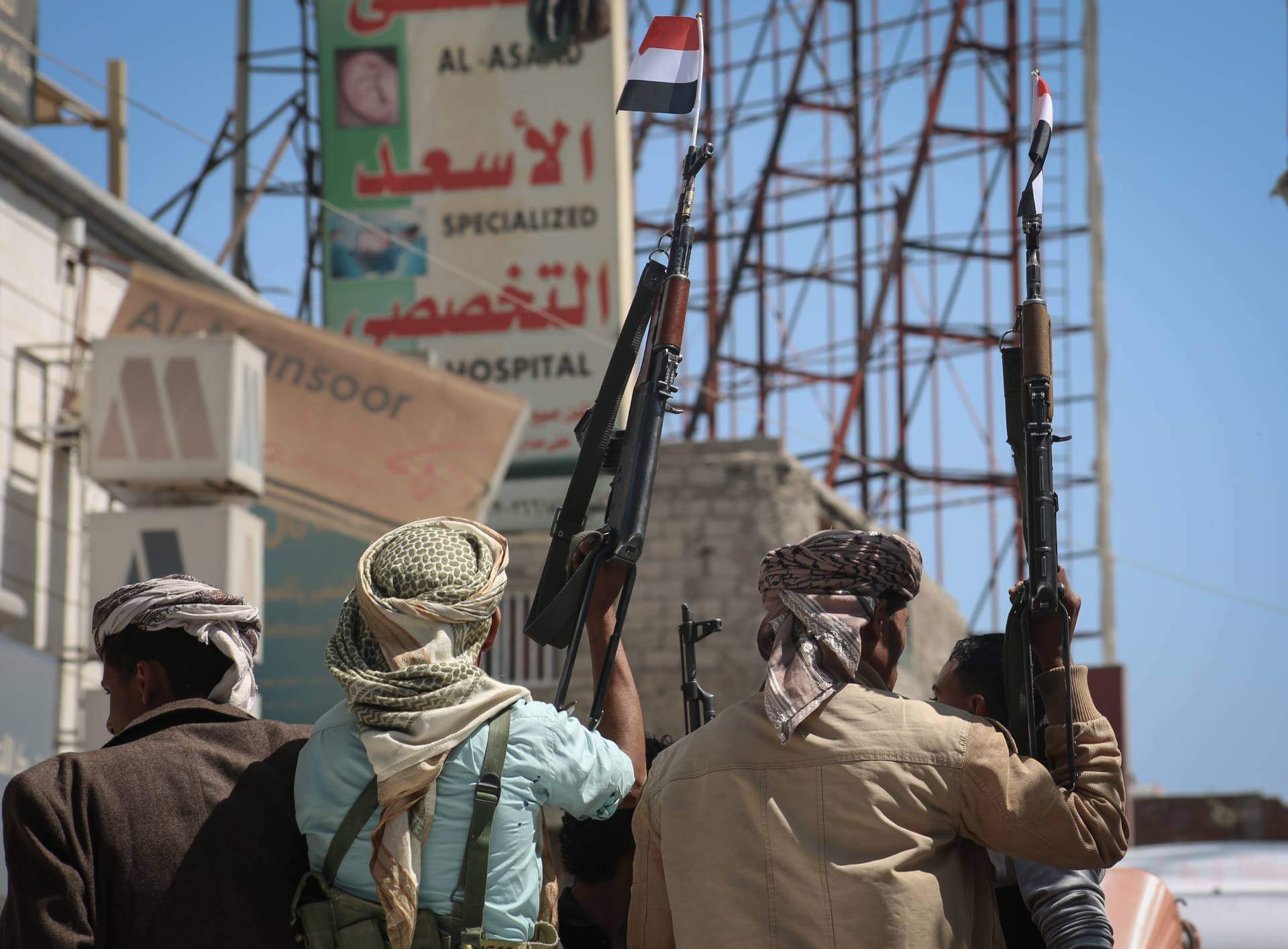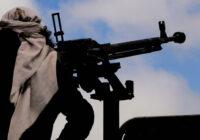Hostilities between Saudi Arabia and Houthi rebels have been on pause since April 2022, but the pathway to peace is unclear. As the fragile détente between Saudi Arabia and Iran-backed Houthi rebels enters its 19th month, a diplomatic impasse is leading to desperate actions. Talks between the parties failed in April. A month later, in the South, a group of secessionist parties belonging to the Southern Transitional Council (STC) signed the Southern National Pact (SNP). The parties demanded a greater voice for the South in the Yemeni peace process and reaffirmed their commitment to establishing an independent state there.
The announcement sent shockwaves throughout Yemen. The Houthis and Muslim Brotherhood affiliate al-Islah immediately complained, but Saudi authorities and fellow members of the Saudi-led coalition — formally on the same side of the war as the STC — also expressed concerns about the strengthening of the southern parties. Saudi Arabia fears it could lose influence over parties within the Political Leadership Council (PLC), the internationally recognized Yemeni government’s executive body.
The first step taken by Saudi Arabia following the STC announcement was to convene a series of meetings in Riaydh with rivals of the STC that represent Hadhramaut, in the country’s east. The meetings culminated in the establishment of a National Hadhrami Council (NHC), in an apparent move to counter the STC’s Southern National Pact.
Other parties formed the People’s High Council of Resistance, based in the center of the country, for similar purposes.
Some observers present these developments as progress among the opponents of the Houthi in preparation for a break in the Saudi–Houthi détente. On the ground, however, it is obvious the new council is a reaction to growing STC momentum. Yemeni political factions seem to be more concerned about southern secessionism than about the threat the Houthis pose.
What has the STC decided, and why now?
PLC Chairman Rashad al-Alimi had exacerbated North–South tensions in February when he dismissed the southern issue as a priority. This angered southerners and put pressure on the STC to act.
Undoubtedly, this hastened the organization of the Aden dialogue conference hosted by the STC in early May. Southern factions were quick to exploit the optics of the week-long conference through well-coordinated media campaigns. They gave a general audience access to the participants. Longtime political rivals came together in Aden. With over 30 factions signing the SNP, the STC now serves as the umbrella organization for southerners. This is a significant development following recognition under the 2019 Riyadh Agreement as the representative of the southern peoples.
The STC also announced a major restructuring of its executive leadership. It expanded its membership by including some former rivals, including PLC members Faraj Salmin al-Bahsani and Abd al-Rahman al-Mahrami (aka Abu Zaraa’a) as co-vice presidents along with Ahmed Saeed bin Breik. Bahsani and bin Breik are former governors of Hadhramaut and former commanders of the Second Region Command there. This move not only cemented the strategic importance of Hadhramaut, Yemen’s largest province, but it also placed allies of the South within the PLC itself — three of them within the eight-member council.
The accession of Bahsani, a Hadhrami, and Abu Zaraa’a, a Salafi leader from Lahj, as vice presidents could highlight two goals of the STC. The first is to cement the influence of the South within the PLC with regard to Saudi Arabia. The members of the PLC are seen as hand-picked by Saudi Arabia, so their legitimacy and influence cannot be questioned. Second, the vice presidents are military leaders with a history of opposition to al-Islah’s influence in the South. As former commanders of the Second Region, based in Mukalla in southern Hadhramaut, bin Breik and Bahsani represent the southerners’ opposition to the al-Islah-affiliated First Region Command, based in Sayyun in northern Hadhramaut. Further, Abu Zaraa’a served as commander of the STC-affiliated Amalaqa Brigades, which act as the tip of the southern forces’ spear from the Red Sea coast to Shabwah. In an environment of constant rebalancing acts, the message is abundantly clear.
Saudi overreach derails Riyadh Agreement
The success of the STC-led dialogue among southern factions has undoubtedly raised fears of southern secessionist ambitions. Fears among Yemeni parties have grown since the signing of the Riyadh Agreement, which legitimized the STC, in November 2019. Now, nearly four years since the agreement and a year and a half after the establishment of the PLC, all efforts to stabilize the liberated areas and unite the Houthi’s rivals have failed.
The STC has gained tremendous momentum since former president Hadi replaced the al-Islah-affiliated governor of Shabwah with an ally of the STC in December 2021. The conflict between al-Islah and the STC then shifted to northern Hadhramaut, with the STC demanding the ouster of the al-Islah-affiliated leadership of the First Regional Command. These developments have raised concerns in Riyadh over the extent of influence by the STC beyond its core in Aden, possibly consolidating in northern Hadhramaut along the Yemen-Saudi border.
Saudi Arabia has attempted to solidify its influence in Hadhramaut. Observers in south Yemen remain unsettled by Saudi Arabia’s decision to host tribal leaders from Hadhramaut soon after the STC dialogue conference in Aden. The gathering of Hadhrami leaders was made public from the first flight from Sayyun to Riyadh aboard a Saudi military aircraft. Meetings in Riyadh were also broadcasted by media outlets, and on June 20 the group announced the establishment of the Hadhramaut National Council (HNC). The charter, yet to be made public, was then signed on July 27. Al-Islah was the first political party to announce signing the charter.
Further antagonizing the STC and its base across southern Yemen, members of the new council met with Saudi officials and Alimi. The composition of the council, with a number of leaders from the al-Islah, makes it appear to be a direct rival to the STC. Among the notable al-Islah members of the council are Bader Basalama, Mohsen Basura, Adel Bahamid and Abdullah Saleh Al Kathiri. Other high-profile leaders on the council include members of the General People’s Congress (GPC), the former ruling party under deposed president Ali Abdullah Saleh. Alimi is also a member of the GPC.
Tension further escalated in early July when the STC organized a demonstration outside the Sayyun Palace and gunmen affiliated with members of the new council met unarmed demonstrators. In neighboring Shabwah, another group of tribal leaders announced the Alliance of Sons and Tribes of Shabwah, another attempt to challenge the STC.
The latest move exacerbating tensions among competing parties was the announcement of the Supreme Popular Resistance Council for al-Jawf and Mareb under Hamoud al-Makhlafi, a sheik from Taiz. Sheik Hamoud, an al-Islah affiliate, resides in Turkey but remains highly influential in the city of Taiz. This new council has met opposition even within Mareb City, a stronghold of al-Islah. It is undetermined if Saudi Arabia knows about or supports this group.
The factional lines are being drawn. As Saudi Arabia draws together its anti-STC allies, it puts the unity established by the Riyadh Agreement at risk.
Imminent escalation on two fronts
Meanwhile, optimism remains among UN officials who view the lopsided prisoner exchange of April 2023 as a step forward. The completion of the oil transfer from the FSO Safer off the Red Sea of Hodeida is also touted as a major diplomatic victory by the UN. This has led the mainstream consensus to share the UN’s optimism about their efforts to restart the peace process. However, the Safer operation’s costs now surpass the current potential revenue from the oil. The wreck, in any case, remains under Houthi control and is still vulnerable to floating sea mines released by them.
Despite UN positivity, the fragile détente is on the brink of collapse. Houthis continue to clash with southern forces in al-Dhale and Yafa’, and new clashes have been reported across Taiz. The Saudi–Houthi détente has merely eliminated cross-border strikes while the rebels have reinforced their positions across all fronts. Furthermore, the Houthi head of the Supreme Political Council (SPC), Mahdi al-Mashat, recently threatened new cross-border missile strikes.
Saudi Arabia evidently expects an imminent escalation by the rebels. Houthi tactics always involve escalating rhetoric or increasing demands to extract maximum concessions from Saudi Arabia or the UN. The period since October 2022 has not seen any changes in Houthi behavior. They only adhered to Saudi Arabia’s agreement on halting cross-border strikes because it has allowed them to regroup, train and redeploy militia across their territory.
With crisis looming, US Special Envoy Tim Lenderking is once again in the Gulf region following a visit by UN Special Envoy Hans Grundberg to Riyadh in August.
Saudi Arabia’s move to support the establishment of new subregional councils in Hadhramaut and Shabwah, in particular, may prove highly counterproductive. As the Houthis prepare for a renewal of hostilities within Yemen and across the border, the emergence of competing councils will exacerbate the fragmentation of the Houthi’s rivals. Saudi Arabia hopes to unify anti-Houthi factions under the Riyadh Agreement, but its mismanagement of rivalries across southern Yemen and within the PLC has paved the ground for potentially larger losses in Hodeida and Taiz. Ultimately, Houthis may choose to re-engage southern forces, a move which could drag the United Arab Emirates — which the Houthis have recently attacked — back into the conflict and further destabilize the region.
[Lee Thompson-Kolar and Anton Schauble edited this piece.]
The views expressed in this article are the author’s own and do not necessarily reflect Fair Observer’s editorial policy.
Support Fair Observer
We rely on your support for our independence, diversity and quality.
For more than 10 years, Fair Observer has been free, fair and independent. No billionaire owns us, no advertisers control us. We are a reader-supported nonprofit. Unlike many other publications, we keep our content free for readers regardless of where they live or whether they can afford to pay. We have no paywalls and no ads.
In the post-truth era of fake news, echo chambers and filter bubbles, we publish a plurality of perspectives from around the world. Anyone can publish with us, but everyone goes through a rigorous editorial process. So, you get fact-checked, well-reasoned content instead of noise.
We publish 2,500+ voices from 90+ countries. We also conduct education and training programs
on subjects ranging from digital media and journalism to writing and critical thinking. This
doesn’t come cheap. Servers, editors, trainers and web developers cost
money.
Please consider supporting us on a regular basis as a recurring donor or a
sustaining member.
Will you support FO’s journalism?
We rely on your support for our independence, diversity and quality.








Comment